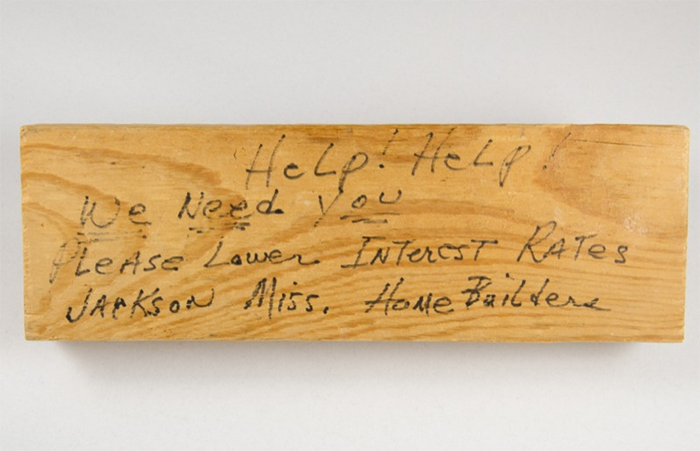Nowhere to go but up? How increasing mortgage rates could affect housing
With your interest rates this high high high
How am I ever gunna own what I buy
“My Own Place” by Terri Hendrix
We’re in an era of historically low mortgage interest rates and the expectation is that interest rates have nowhere to go but up. But how quickly will rates increase and how high will they go? If they do rise, what will be the effects on home buyers, homeowners wishing to refinance, mortgage lenders, home builders, and real estate agents? To answer these questions, it’s helpful to review periods when interest rates spiked and analyze the effects, with the hopes of understanding what might happen in the coming years. It’s the next best thing to a crystal ball.
1977 to 1981: When interest rates more than doubled
Let’s start by looking back at the highest rates in recent memory. In 1981, a prospective homebuyer strolling into a bank would be hit with a staggering 18 percent interest rate for a new 30-year fixed-rate mortgage. Just four years earlier in 1977, that same bank would have been asking for 8 percent. This was the most dramatic increase in mortgage rates in the last 50 years.
The historic increase in mortgage rates hit real estate markets hard, dramatically reducing mortgage and housing activity.
- New mortgage originations fell nearly 40 percent, from $162 billion in 1977 to $98 billion in 1981.
- Annual single-family home sales dropped 36 percent, from 4.5 million to 2.9 million.
- The biggest decline was in construction, with housing starts for single-family homes plummeting over 51 percent, from almost 1.5 million to 705,000 by 1981.
In frustration, thousands of home builders mailed wooden 2x4s to the Chairman of the Federal Reserve at the time, Paul Volcker, pleading with him to lower rates.
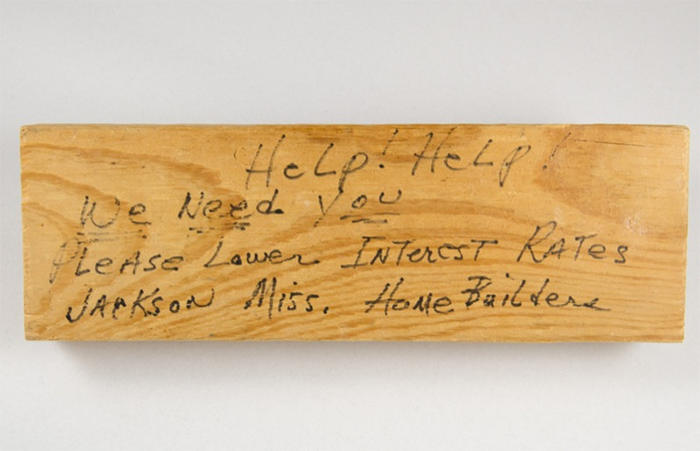
Since the highs of 1981, mortgage rates have mostly trended downward. Could they soar again? Sure, but more recent experiences suggest that the current expected increases in mortgage rates should be more modest and have relatively benign effects on housing and mortgage markets.
The past as prologue
Other recent episodes of rising rates can also inform our expectations about how future increases would affect various market participants—borrowers, lenders, real estate agents, and home builders. We define an increasing rate environment as a period in which the monthly average of the Primary Mortgage Market Survey (PMMS) rate for 30-year fixed mortgages increased by more than 1 percentage point from trough to peak. Using this definition, there have been six episodes of increasing rates since 1990. Exhibit 1 contains a plot of the 30-year fixed rate, with the shaded periods denoting the increasing rate environments. Since 1990, no episode has matched the magnitude of rate increase of the late 1970s. The largest increase was 2.4 percentage points from October 1993 to January 1995.
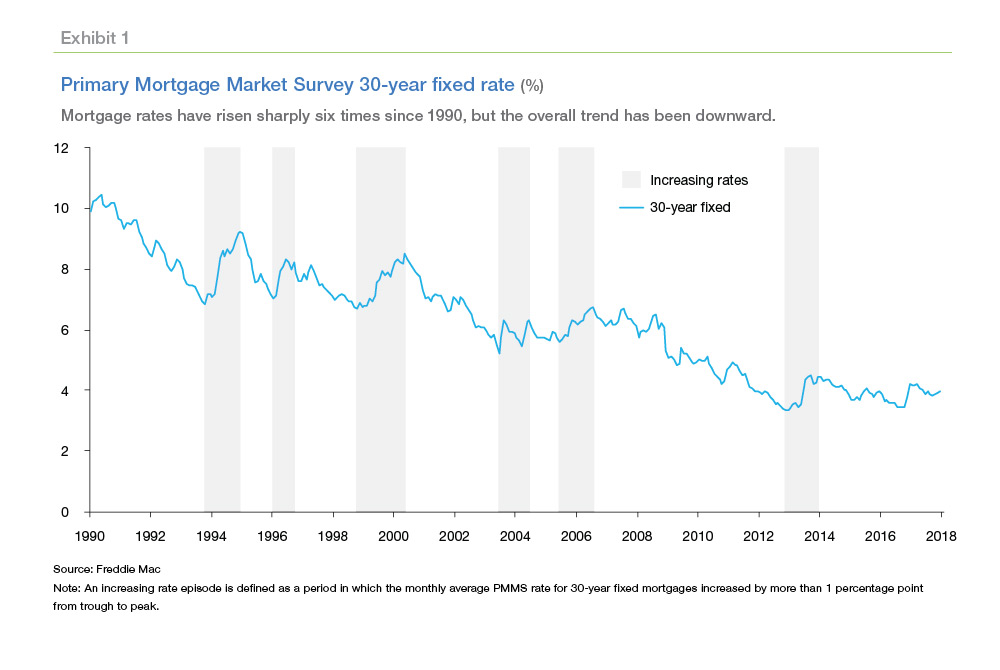
The increasing rate environments we identified are almost always accompanied by reductions in mortgage originations, home sales, and housing starts across the board. Exhibit 2 summarizes the movements in housing and mortgage markets during the episodes since 1990. There are two exceptions where not all measures of activity—originations, home sales, and housing starts—declined. In 1996, originations continued to grow, while homes sales and starts fell. In 2003, the reverse was true: Home sales and housing starts continued to grow, slightly, but origination volume declined by over 40 percent. However, the trend is clear: Mortgage and housing activity fall when rates increase sharply. In the next few sections, we explore the effects of increasing rates on market participants to understand the changes in market activity during these periods.
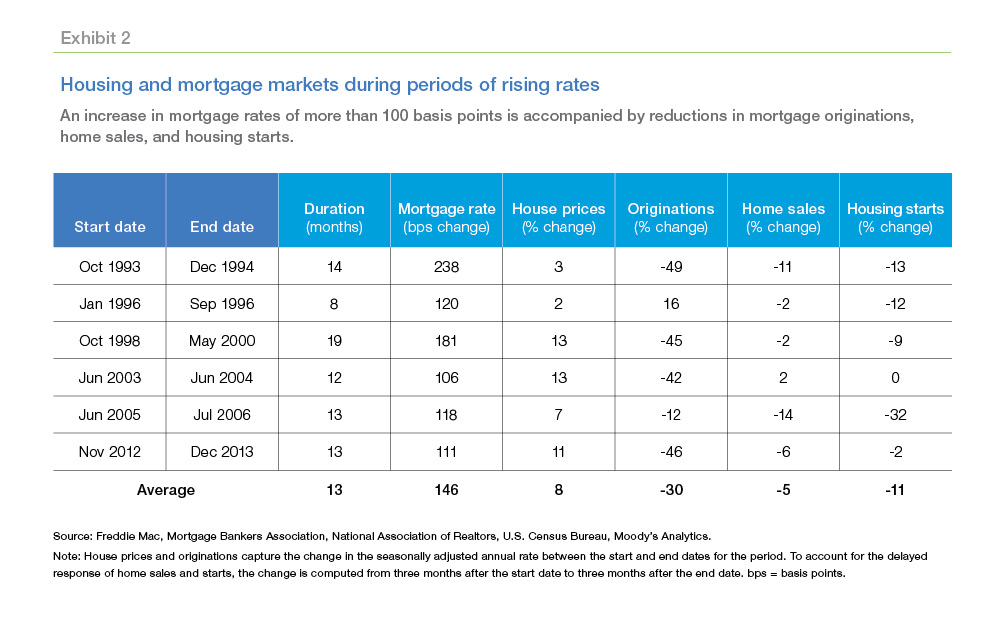
Effects on borrowers
The direct effect of increasing mortgage rates is on the borrowers—specifically, their decision as to which home to buy, when to buy, and how much to borrow. These decisions are heavily influenced by mortgage rates: The higher the rate, the higher the monthly payments required to purchase a home. Exhibit 3 presents an estimate of mortgage payments based on median house prices and interest rates, assuming a 20 percent down payment. As expected, during periods of increasing rates, the monthly payment needed for the median home increases.1 As the monthly payment needed to purchase a home goes up, potential first-time home buyers may find that they can no longer afford some houses either because the extra costs stretch their household budget too thin or they no longer meet lenders’ debt-to-income requirements. Some households can compensate for this by choosing a lower-priced home, while other households may find that it is no longer feasible to own a home and choose to rent.
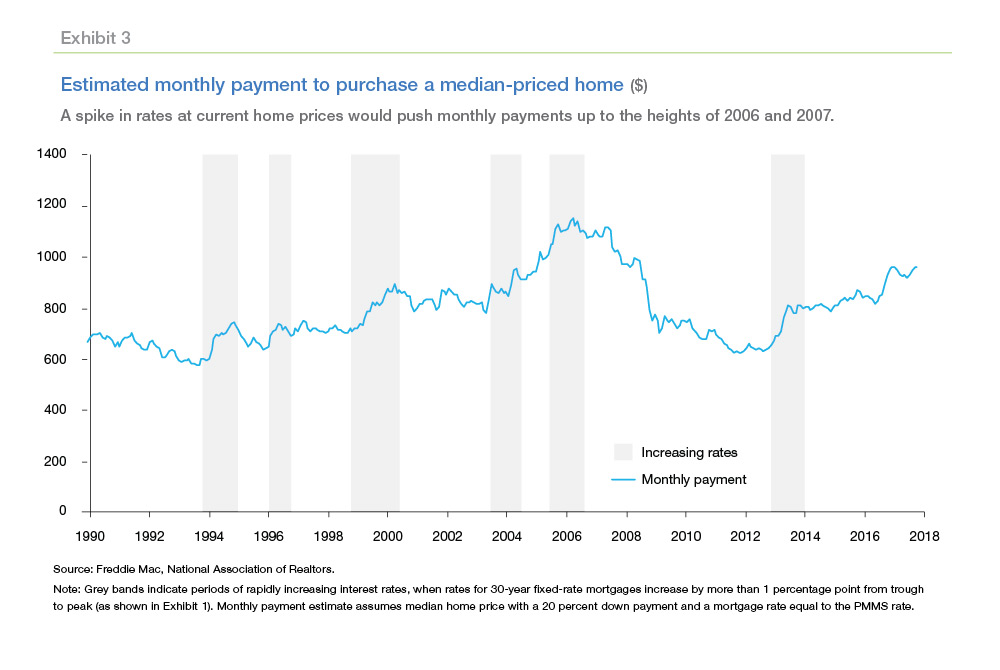
For borrowers who already have a mortgage, the decision to refinance is even more sensitive to changes in the mortgage rate than the decision to purchase a home. The most common reason for borrowers to refinance is to reduce their monthly payment by taking advantage of more favorable loan terms. When mortgage rates are declining, terms become more favorable and refinance activity tends to increase. But when rates are increasing, fewer borrowers find that the available terms are today better than their existing mortgage, so refinance activity slows.
For current homeowners, the decision to buy a new home is typically linked to their decision to sell their current home. These transactions are linked because borrowers often use their home equity for the down payment on a new home. Because of this link, the financing costs of the existing mortgage are part of the homeowner’s decision of whether and when to move. Once financing costs for a new mortgage rise above the rate borrowers are paying for their current mortgage, borrowers would have to give up below-market financing to sell their home.2 Instead, they may choose to delay both the sale of their existing home and the purchase of a new home to maintain the advantageous financing. However, many households must move—for instance, to relocate for a new job or because their current house is no longer the right size for their family—and will accept a marginal increase in financing costs to do so.
Effects on mortgage lenders
Mortgage lenders thrive on the volume of mortgages originated. As mortgage rates increase, borrowers reduce their demand for mortgages, primarily for refinances but also for purchases. Exhibit 4 tracks total mortgage origination volume per month since 1990, with the periods of increasing rates shaded gray. The data are seasonally adjusted, to take account of the fact that mortgage activity is highly seasonal, picking up in spring and summer.3 In most periods when rates increased, mortgage originations declined by over 40 percent.4 The primary driver is the reduction in refinance activity from fixed-rate borrowers who are enjoying below-market financing. These borrowers have no reason to refinance their mortgages once rates have increased. The refinance activity that remains is primarily cash-out refinances and refinances to discharge mortgage insurance on an FHA loan originated with less than 20 percent down payment.5
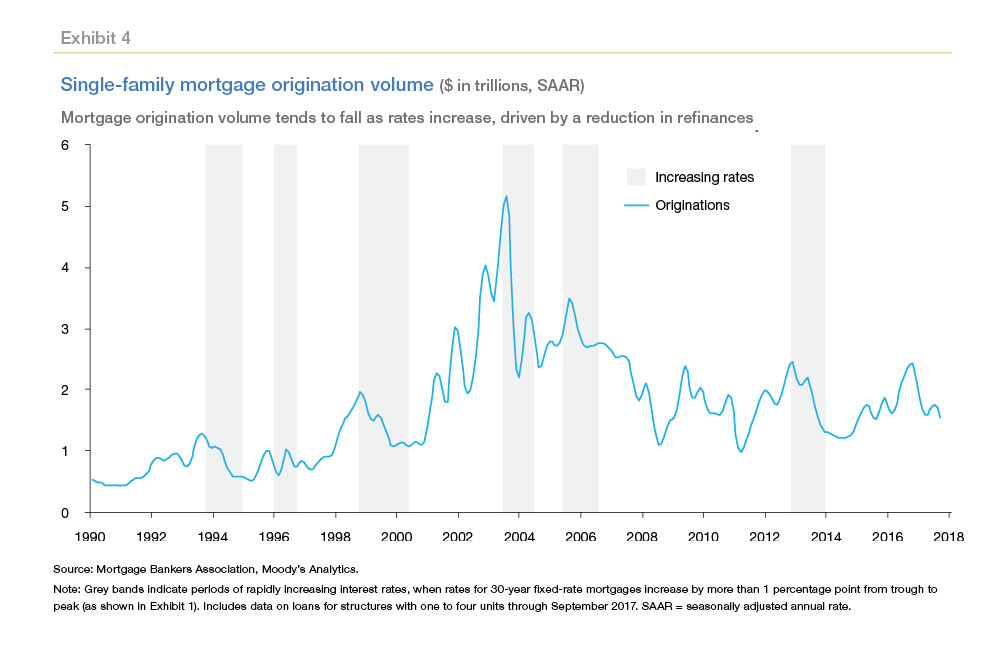
Effects on real estate agents
Real estate agents contribute to housing markets by facilitating home sales. In Exhibit 5, we can see the decline in home sales during most of the episodes, which is delayed from the start of the increase in rates, unlike originations. Historically, decisions to buy or sell a home are negatively affected by rising mortgage rates, but only modestly so. As noted, some households must move, thus sustaining the purchase volume. Depending on the specific conditions of the housing market, the downside to real estate agents of lower volume can be offset by an increase in house prices.
While there is a drop in the demand for homes, there is an associated drop in the supply of homes from the link between the selling and buying decisions. As both supply and demand move together in this way they have offsetting effects on price—lower demand decreases price and lower supply increases price. Exhibit 6 shows the Freddie Mac National House Price Index from 1990 to June 2017. It is unresponsive to movements in interest rates. In the current housing market, the driving force behind the increase in prices is a low supply of both new and existing homes combined with historically low rates. As mortgage rates increase, the demand for home purchases will likely remain strong relative to the constrained supply and continue to put upward pressure on home prices. However, the combination of increasing rates and increasing house prices would be a double hit to affordability for first-time home buyers.
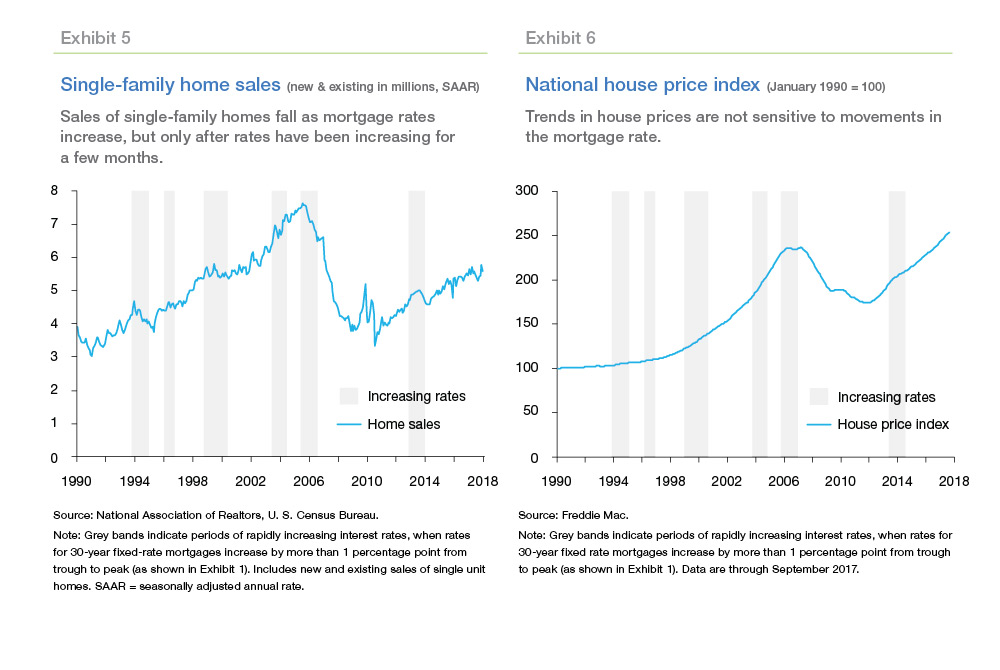
Effects on home builders
Fewer home sales ultimately lead to a reduction in the demand for construction of new homes, hurting home builders. This effect is delayed in the data a few months because of the lapse in time between the decision to build a house and the start of construction. Exhibit 7 contains the recent history of single-family housing starts since 1990, with seasonal adjustment. Home builders are doubly affected by increasing rates because they use financing to fund construction costs. When both interest rates on funding for new construction and mortgages rise simultaneously, home builders are squeezed by a fall in demand and an increase in costs.
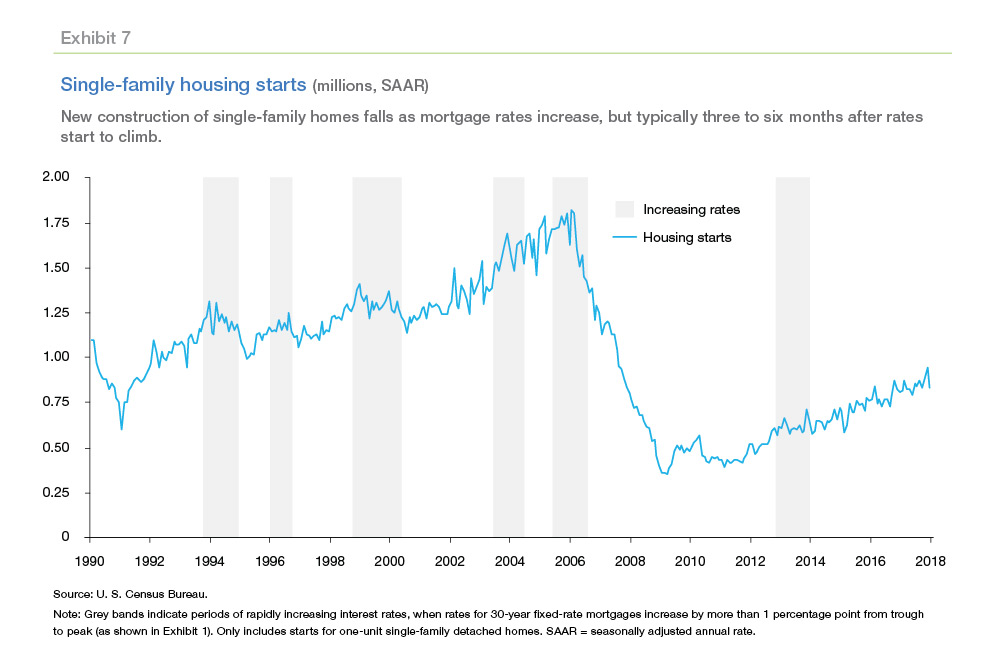
Drivers of 30-year fixed mortgage rates
The historical data presented shed light on the effects of increasing rates on housing decisions and market activity. Next, we consider the risk factors that drive movements in mortgage rates. There are three main risks when issuing a mortgage: credit risk, prepayment risk, and inflation risk. Credit risk stems from the possibility that the borrower might fail to repay the debt. Loans allowing prepayment run the risk that a borrower will pay back early and thus cut off future interest income for the lender. Inflation creates the risk that money in the future will have less purchasing power than today.
It turns out that movements in mortgage rates are largely driven by changes in the expected inflation risk. This pattern is clear in Exhibit 8, which compares movements in the yield of the 10-year U. S. Treasury bond with mortgage rates. This comparison is useful for approximating inflation expectations because inflation risk is the primary risk associated with Treasury securities. The strong linkage between these factors suggests that the drivers of the 10-year Treasury rate are the predominant drivers of mortgage rates.6 Even though rates are driven primarily by inflation risk, predicting changes in a market is challenging because it involves predicting changes in the inflation expectations and effects of those expectations on supply and demand of credit.
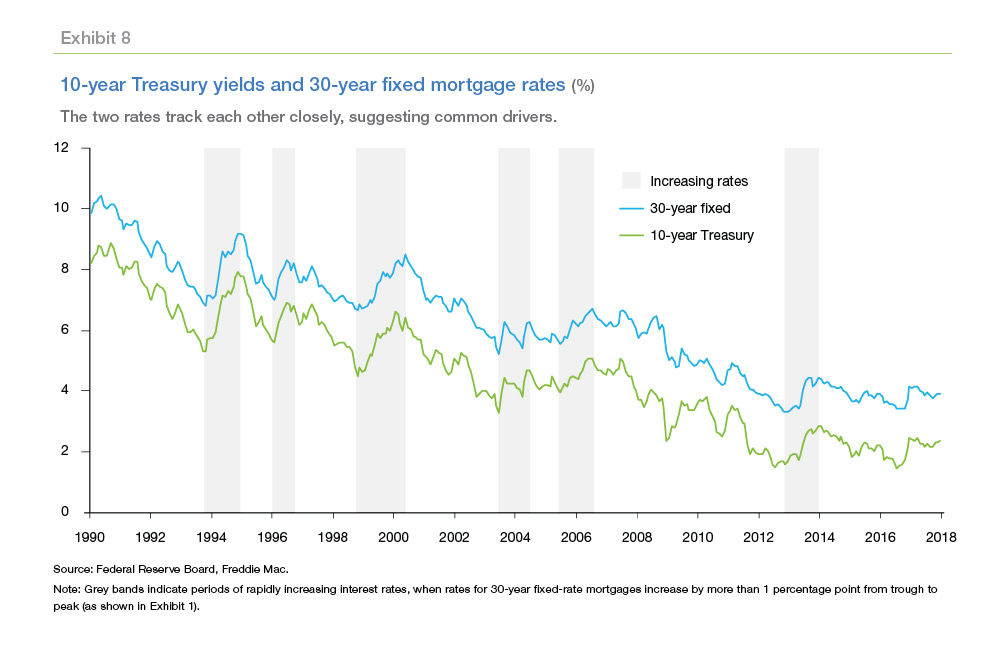
The future of 30-year fixed mortgage rates: Three scenarios
In Exhibit 9, we consider three scenarios for the next cycle in mortgage rates to capture the range of probable outcomes based on prior experience. The first scenario is a continuation of the status quo in which rates hover between 3.5 and 4.5 percent. The movement in the housing markets for the status quo scenario is estimated as the average year-over-year change during the recovery of the housing market since 2011. The second scenario is the average experience based on the market moves during the six episodes since 1990 described in Exhibit 2. The third scenario reflects the most extreme movements in housing and mortgage markets during these six episodes.
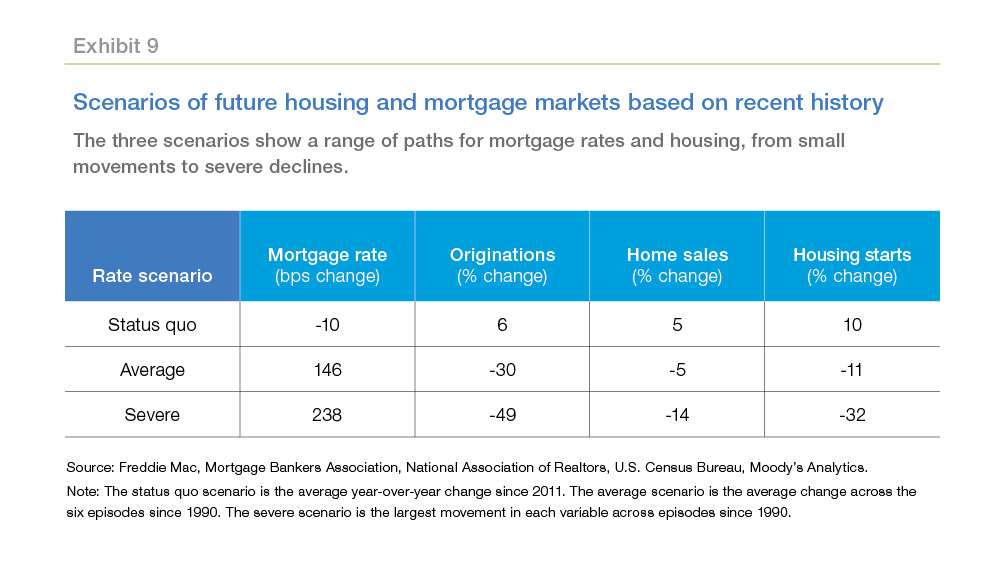
The status quo scenario corresponds to continued expectations of low inflation. Some economists think that a combination of increases in the supply of capital, continued weak aggregate demand for capital, and the slowdown of U.S. productivity growth could lead to an environment of less than full employment, low growth, and low interest rates, sometimes referred to as secular stagnation.7 Under this scenario, mortgage and housing markets would likely plod along, with moderate increases in originations, sales, and starts.
In contrast, the average scenario based on recent history with interest rates rising 146 bps from trough to peak implies a meaningful increase in expected inflation. The most recent low in the 30-year fixed mortgage rate occurred in September 2016, with a monthly average of 3.81 percent. Assuming the average scenario, the 30-year fixed rate would rise above 5.25 percent before declining. The weekly average rate of 4.40 percent, released on February 22, 2018, puts us more than one-third of the way there, as rates have already begun to climb in early 2018. Under this rate scenario, mortgage originations are expected to fall by 30 percent, accompanied by more modest declines in home sales of 5 percent, and a decline in housing construction starts of 11 percent.
Another possibility is that mortgage rates increase for a longer period and remain elevated for an extended period. This could happen if inflation and expectations of future inflation increase.8 The last time there was a sustained increase in rates was from 1977 to 1981. The increase in rates during that period was accompanied by double-digit increases in consumer prices. This severe scenario is estimated by taking the maximum movements during periods of increased rates since 1990. Under this scenario, mortgage rates are expected to increase by 238 basis points, with a 49 percent drop in mortgage origination volume, a 14 percent decrease in home sales, and a 32 percent decline in housing starts.
The specifics of when and by how much mortgage rates move in the near future are still uncertain. However, understanding the incentives of market participants and the historical context informs the expected response of housing and mortgage markets to movements in mortgage rates. Given this context, the expected increase in mortgage rates would suppress growth in the mortgage and housing markets, and lead to declining markets if the increase is large enough or lasts for long enough. But for now, mortgage credit is still historically cheap if you get in while the getting is good.
PREPARED BY THE ECONOMIC & HOUSING RESEARCH GROUP
Doug McManus, Quantitative Analytics Director
Elias Yannopoulos, Quantitative Analytics Senior
1 Higher rates would not increase mortgage payments if house prices fell enough to compensate for the rise in rates.
2 For a rate increase of 100 bps (1 percent) on a $200,000 loan, the value of holding on to below-market financing is at most $2,000 per year of savings in interest payments.
3 Seasonal adjustment is a method that removes predictable seasonal fluctuations in the data. The strong seasonality in mortgage activity makes it hard to draw comparisons month-to-month without some adjustment.
4 An exception is 1996, when the rate increase was short lived and had only a small impact on origination volume.
5 Typically, borrowers making a down payment of less than 20 percent of the purchase price of the home will need to pay for mortgage insurance. FHA loans require mortgage insurance payments even if the balance falls below 80 percent of the home value, but these loans can be refinanced without mortgage insurance.
6 This is not true for adjustable rate mortgages, which are closely linked to short-term interest rates.
7 See former Fed Vice Chairman Stanley Fischer’s October 2016 speech at the Economic Club of New York (“Why Are Interest Rates So Low? Causes and Implications,” https://www.federalreserve.gov/newsevents/speech/fischer20161017a.htm), and the 2016 IMF Mundell-Fleming Lecture by former Treasury Secretary Lawrence H. Summers (“Macroeconomic Policy and Secular Stagnation”).
8 Esther George, president of the Kansas City Federal Reserve, has warned that too much accommodation runs the risk of overheating the economy, which could put in motion an undesirable increase in inflation. See “Monetary Policy in a Low Inflation Economy,” https://www.kansascityfed.org/~/media/files/publicat/speeches/2017/2017-george-centralexchange-10-11.pdf.






